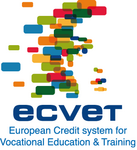Using ECVET for Geographical Mobility
 Using ECVET for Geographical Mobility Part II of the ECVET's user guide. This part II of the ‘ECVET Users’ Guide’ explains the role of ECVET in facilitating the transnational mobility of learners. It presents some possible scenarios for using ECVET in this context. It seeks to encourage ECVET mobility through explaining the added value and the potential of using ECVET for mobility. It is part of a series of documents that constitute the ‘ECVET Users’ Guide’. Download ECVET User guide Part II - Using ECVET for Geographical Mobility.
Using ECVET for Geographical Mobility Part II of the ECVET's user guide. This part II of the ‘ECVET Users’ Guide’ explains the role of ECVET in facilitating the transnational mobility of learners. It presents some possible scenarios for using ECVET in this context. It seeks to encourage ECVET mobility through explaining the added value and the potential of using ECVET for mobility. It is part of a series of documents that constitute the ‘ECVET Users’ Guide’. Download ECVET User guide Part II - Using ECVET for Geographical Mobility.
ECVET and geographical mobility
Substantially increasing transnational mobility of VET learners and teachers, and recognising the knowledge, skills and competencies they have acquired abroad, will be an important challenge for the future. The Bruges Communiqué on enhanced European Cooperation in Vocational Education and Training.
While mobility in vocational education and training (VET) is already happening, the political ambition in Europe is to increase the numbers and the duration of mobility exchanges significantly. Development of learning mobility in VET implies putting in place a range of support activities adapted to the target group of VET learners including for example: language learning, creating funding opportunities or other preparatory and accompanying measures. The recognition of qualifications and the transparency of what learners have achieved abroad are core to mobility in vocational education and training. ECVET was designed as one of the European instruments to improve this recognition and transparency (other instruments being for example, the European Qualifications Framework or Europass).
2.1 Learning mobility using ECVET
ECVET supports the valorisation of learning mobility because:
• The learning outcomes approach ensures a better understanding and comparability of qualifications and learning achievements across countries. When using ECVET for learning mobility, the learning outcomes that the learner is expected to achieve abroad are clearly agreed by the partner institutions and stated in a Learning Agreement. Consequently everyone, including the home institution, the host institution and the learner; have a shared understanding of the objectives of the mobility. Following the participation in appropriate learning activities, learners acquire the expected knowledge, skills and competencies and they are assessed on what they have achieved. The learning outcomes that they have achieved abroad are documented in a transcript of record and thus made visible.
• The validation and recognition of learning outcomes are in the framework of mutual trust among partner institutions.
Individuals’ mobility periods are set in a broader framework of agreements. Partner institutions set the conditions for smoother exchanges of learners and develop mutual trust. They also agree to the conditions under which learners’ credit (i.e. assessed learning outcomes) achieved abroad will be validated and recognised. These agreements are formalised in Memoranda of Understanding.
ECVET can accommodate different forms of validation and recognition of learners’ learning outcomes, such as:
• Awarding credit for the unit(s) of learning outcomes concerned.
• Exemption from an assessment or its part.
• Transcription of the learning outcomes achieved abroad in learners’ transcripts of record.
• Awarding additional credit to what s/he would have normally achieved.
• The integration of mobility into learning pathways.
When using ECVET all interested parties (learners, employers, education and training providers) will have a clearer understanding and evidence about the added value of learning in a partner institution. ECVET can improve the validation and recognition of both key competencies (such as foreign language skills) as well as more technical skills and competences.
Learners will have the chance to enrich their learning pathway by acquiring abroad the knowledge, skills and competences which they would not have had the possibility to achieve in their home institution (for example, because of the differences in technologies used or because of the variety of products). ECVET may also help VET providers to respond to certain labour market needs by sending learners abroad for units they cannot deliver themselves (for example, because of the investment necessary to purchase the technology). For the same reasons, VET providers may be able to attract new learners from abroad.
What does it mean to use ECVET for transnational mobility?
In short, using ECVET for transnational mobility implies that:
• In one country, the competent institution (the host institution) assesses the learner’s achievement of learning outcomes (as defined in units) and provides evidence of the results of the assessment (written statement on learning outcomes achieved or an assessment grid for example).
• In another country, the competent institution (the home institution) validates and recognises credit for units of learning outcomes. ECVET credit points are allocated to the learning outcomes, enabling the learner to add these credit points to those necessary to achieve a particular qualification. The unit(s) of learning outcomes achieved abroad is (are) recorded in a learner’s transcript of record.
For organised mobility (i.e. when the learner goes abroad as part of an inter-institutional agreement), the process takes place in the framework of a Memorandum of Understanding and it is supported by an individual Learning Agreement. Therefore, the learning outcomes to be achieved, the assessment, validation and recognition processes are agreed between the competent institutions a priori thus facilitating the recognition of credit.


/https%3A%2F%2Fp1.storage.canalblog.com%2F20%2F55%2F1154600%2F122555108.png)
/https%3A%2F%2Fencrypted-tbn2.gstatic.com%2Fimages%3Fq%3Dtbn%3AANd9GcTi5Hkm0uJx8RuXLdIN4NSGeutjLR0NZnG3tTJBq9IYhTpD2Hdf5SvxmA)
/https%3A%2F%2Fprofilepics.canalblog.com%2Fprofilepics%2F1%2F0%2F1076071.jpg)